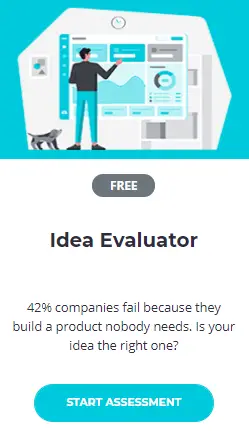Business diagnostic tools for startups & SMEs
If you’re a startup or small business owner, it’s essential to have access to the right business diagnostic tools. By using these tools, you can identify potential areas of improvement and take steps to rectify them.
Starting a business is hard enough, but making it successful is an even greater challenge. There are countless factors to consider and if you’re not careful, your business can quickly become unprofitable. This is why it’s important to regularly diagnose your business using certain tools. By doing so, you can adjust your course as needed and keep your business on track for long-term success.
In this blog post, we’ll share some of the best business diagnostic tools for startups and SMEs. Whether you’re looking to streamline your operations or boost your bottom line, these tools will help you get started on the right track.
Also, don’t forget to check out our startup idea generator which helps you generate over 10,000 startup business ideas. Our business idea evaluation tool is one of our business diagnostic tools that will help you evaluate your startup idea.
What is a ‘business diagnosis’?
Every business is different and will have different strengths and weaknesses. It’s important for entrepreneurs and small business owners to know what these are so they can capitalize on their strengths and work to improve their weaknesses. This is where business diagnosis comes in.
Business diagnosis is the process of evaluating a business’s current situation and identifying the factors that are impacting its success. It can help entrepreneurs understand where their business stands, identify areas for improvement and create a plan for growth. If you’re looking to grow your business, it’s essential to take some time for a business diagnosis.
How to Diagnose a Business
Business diagnosis is vital for identifying areas for improvement and growth opportunities. Follow these key steps to effectively diagnose your business’s health:
- Define Areas of Focus: Determine key aspects of your business to analyze such as finances, operations, marketing, customer acquisition and retention, competitive landscape, etc. Prioritize areas of concern.
- Collect & Analyze Data: Gather metrics, sales reports, customer feedback and other quantitative and qualitative data sources. Identify positive and negative trends. Benchmark against industry standards.
- Perform SWOT Analysis: Evaluate your business’s strengths, weaknesses, opportunities and threats to gain strategic insights. A SWOT can help determine the root causes of issues.
- Identify Core Issues: Pinpoint the underlying problems impacting top priorities based on data findings and SWOTs. Ask why is this happening and what can be improved.
- Develop Action Plan: Create specific, measurable goals to address diagnoses. Outline tasks, owners and deadlines. Continuously track progress over time through key metrics.
Following a methodical diagnosis process is essential to unlock growth opportunities and improve overall business performance. Adjust approaches as needs evolve.
Here is an example of how to diagnose a hypothetical retail business:
Suppose we have a small retail clothing boutique that has seen declining sales over the past 6 months. Here’s how we might diagnose issues with the business:
- Define Areas to Analyze We would look at sales trends, foot traffic, inventory management, buyer behaviors, pricing, competitors, marketing initiatives, brand perception, etc. Poor sales are a top priority issue.
- Collect & Examine Data Upon analysis, we discovered sales are 15% below last year. Foot traffic also dropped by 10% over the same time frame. Buyer demographics shifted to an older age group. Inventory is also overstocked in lower-priced items.
- SWOT Analysis Strengths included a loyal customer base and quality offerings. Weaknesses were pricing not competitively aligned and poor inventory mix. Opportunities included better leveraging influencer collaborations. Local competitors launching e-commerce sites posed a threat.
- Identify Core Issues Two core issues were identified – the brand was aging along with long-term clientele while also being priced higher than newer competitors. These factors contributed to declining metrics.
- Create & Implement Action Plan To address diagnoses, merchandising was refreshed to appeal to a younger demographic. Prices were strategically reduced on key items. An Instagram partnership campaign was launched to increase awareness and drive traffic. Outcomes are to be closely tracked weekly.
This demonstrates an approach to diagnosing a hypothetical retail business, with the ultimate goal to improve performance and sales trajectory based on data-driven insights.
What is a business diagnosis assessment?
A business diagnostic assessment can help you identify the strengths and weaknesses of your company, and give you a roadmap for improvement. Here are four reasons to consider taking a business diagnostic assessment:
1. To gain a better understanding of your company’s overall performance
2. To identify areas in need of improvement
3. To benchmark your company against others in your industry
4. To receive expert advice and recommendations from professionals
Business diagnostics for consulting
Diagnosing your own business can be difficult- you may be too close to the situation to see problems clearly, or you may not have the expertise needed to identify certain issues. This is where consultants come in. Business consultants are trained professionals who can help you assess your current business practices and offer recommendations for improvement. But it’s also something you can do on your own.
If you’re thinking about hiring a consultant, make sure you choose someone with experience in your industry and who offers comprehensive services. A good consultant will be able to help you.
If you’re a business consultant, one of the most important things you can do for your clients is to help them diagnose their business problems. By understanding the root cause of their issues, you can develop targeted solutions that will help them improve their operations and performance.
If your business uses an appropriate Business diagnostic tool, you might be able to develop strategies for improvement. In no particular order, we have listed the 10 best tools available out there.
Tactyqal.com
We’re mentioning our own product because it’s the only FREE option out there and is used by thousands of entrepreneurs and startup founders. Using various assessments on the site you can make some of the most important decisions for your startup including evaluating business ideas, finding out if you’re hiring the right person, can you raise venture capital, do you have a diverse team, etc.
MENZIES BUSINESS DIAGNOSTIC TOOL
From its viable product to control capacity, any business should have 12 cornerstones. Menzies business diagnostic tool will help you assess these, based on your answers. You can use this tool to assess your business’ profitability, risk, and business value. After finishing the tool, the report will be sent to your email. Along with providing the score, you will also be given certain recommendations that will help you resolve these issues. The priority scale will help you understand the areas that require maximum focus. You can then contact them to get a tailored plan for your business.
The BIR by RAPIDBI
The BIR or the Business Improvement Review is a holistic business diagnostic tool that helps businesses identify needs and make improvements accordingly. Along with being one of the best online business diagnostic tools, it is also cost-effective. You can use this tool to detect all your business’ strengths and weaknesses. It helps in assessing various things for a business including organizational culture, employee engagement, and even help you perform a health check.
Where Now Consulting Business Diagnostic Tool (WBD)
If you want a quick assessment of your company’s culture, performance, and strategy, the WBD is an excellent business diagnostic tool. It analyses your leadership team and gives a wider view of your business. While doing so, this tool provides you with insights and areas that you need to focus on. Along with helping you understand your business’s strengths, it also underlines all the weaknesses that might be stumbling your business down. Using the report generated from this tool, you can pick out opportunities that would catalyze growth. With 130 questions, the members you’ve added would also receive a link to this survey. The individual results that are confidential for each member are then run against an algorithm that acts as a guideline, highlighting personality, strengths, and weaknesses.
CORE Diagnostic Tool
Instead of a more complicated business diagnostic tool, if you want something less complicated and more of a self-assessment, CORE’s business diagnostic tool is ideal. From the report generated, you can determine organizational readiness when plotted against product readiness. After completion, you can use these results to determine your company’s strengths and other weaknesses. You can compare these results to your previous data to help you reach a good conclusion.
GPS Business Diagnostic
If you are struggling to understand your business issues, another great tool that will help you understand the strategies and help you accelerate growth is the GPS business diagnostic tool. This diagnostic quiz is by WK. Along with having 25 questions that would take not more than 5 minutes, you will also identify all key factors that will lead you towards success. You will be able to assess the ten most important parts of running a business. They are innovation, technology, systems, strategy, marketing, sales, people, implementation, leadership, and profit.
CEO Business Diagnostics
This tool is a very simple online Business Assessment Tool using which you can rate your company’s various areas including financial health, competitors, operations, etc. The report generated at the end will provide insights about your business based on the key corporate performance indicators. Each of these indicators is explained neatly for you to understand them better in this online assessment. This tool is owned and put together by CEO Business Diagnostics. Apart from this online assessment, they also have several other unique tools that help you understand your business. Some of the other features are BD Online Assessment, Ansoff Matrix, SWOT Summary, etc. Although the price of their suite is not mentioned, you can place an order to get a quote.
Business Diagnostic Tool by Better Business Expert
The Better Business Expert’s tool is a comprehensive business diagnostic tool that will help you identify various areas of your business you need to focus on. This tool uses several critical performance drivers such as strategy, financials, partnerships, processes, and people to assess your business. The 5 drivers are further divided into various sectors that will give you detailed insights. The report at the end of this assessment is based on your membership package and will help you in overcoming the challenges your business might be facing. Additionally, the report is comprehensive and personalized for your business. Each package is priced at a particular rate with the most basic one starting at £295.
Change Management Diagnostic Tool by Changefolio
CHANGEFOLIO has several business assessment tools that will help you in identifying the risks and strengths of a change that you might want to integrate into your organization. Along with searching for themes from the data entered, these tools also measure readiness which will help you in aligning the new changes. From Leadership Alignment to Capability assessment, there are various tools that will help your organization grow effectively. These tools can be downloaded from their page at a not-too-expensive price. Based on what your business needs, you can go through their tool catalog and choose the assessment that is more suited for your business.
Tooliers
The Marketing Lens by Tooliers is a business diagnostics and growth tool that will help you analyze your current marketing activities. After taking this assessment, you will be presented with a report that is tailored for your business. This assessment will not take more than 24 minutes. The final report is visual and will help you understand all the areas you need to prioritize to gain more customers. When you purchase this Marketing Diagnosis tool for your business at just $77, you will get a free book with 101 business tactics.
How can you find the right business diagnostic tool for your business?
There are a few key factors to consider when choosing a business diagnostic tool.
First, you need to identify your company’s specific needs. What are the areas of your business that you want to improve? Once you know this, you can begin to narrow down your search for the right tool.
Next, you’ll want to consider the features of different business diagnostic tools. What kind of data do they collect? How easy is it to use the tool? Does it provide customizable reports? Answering these questions will help you determine which business diagnostic tool is right for your business.
Finally, you’ll want to think about the cost of the business diagnostic tool. Some tools are free, while others can be quite expensive. Be sure to consider your budget when choosing a tool.
With these factors in mind, you should be able to find the right business diagnostic tool for your business. By taking the time to choose the right tool, you can improve the efficiency of your business and make better decisions about your business’s future.
10 tips for getting the most out of your business diagnostic tools
1. Make sure you choose a tool that meets your specific business needs.
2. Consider the features of different business diagnostic tools.
3. Compare the costs of different tools before making a decision.
4. Use the tool to collect data about your business operations.
5. Use the data collected by the tool to improve your business operations.
6. Make sure you understand how to use the tool before using it.
7. Train your employees on how to use the tool.
8. Use the tool regularly to monitor your business operations.
9. Update your tool regularly to ensure you have accurate data.
10. Use the data from your business diagnostic tool to make informed decisions about your business.
By following these tips, you can get the most out of your business diagnostic tools and use them to improve your business operations.
How do businesses use benchmarking to improve productivity and profit?
There’s no question that businesses need to be productive to be successful. But what exactly does productivity mean? And how can businesses make sure they’re as productive as possible?
Benchmarking is a process businesses use to compare their performance against other similar organizations. By understanding how their peers are achieving results, businesses can identify areas where they may be falling behind and take steps to improve.
When done correctly, benchmarking can help businesses boost productivity and profits. In this blog post, we’ll explore how businesses can use benchmarking to improve their operations.
Conclusion
To summarise, using an external business diagnostic tool or assessment will give you a bigger picture of your business. It helps you to work backward and answer questions about your business that you were not able to figure out and possibly set it on the right path.
Once you understand the causes, you can correlate them with the effects that certain decisions might have on your business and the above-mentioned tools will help you do this. But before choosing one, understand all your business needs to personalize the tool for your business.
If you have just started a business or planning to start one very soon, use our AI-powered business assessments to help you make fast well-informed decisions on every aspect of the business. If you’re raising venture capital funding, check out our venture capital funding tool and find out how your startup is positioned to raise early-stage venture capital.






